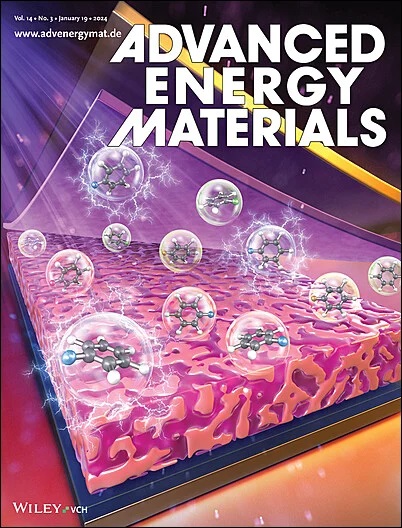Harnessing Solar Energy for Ammonia Synthesis from Nitrogen and Seawater Using Oxynitride Semiconductors
IF 26
1区 材料科学
Q1 CHEMISTRY, PHYSICAL
引用次数: 0
Abstract
Green ammonia evolution by photocatalytic means has gained significant attention over recent decades, however, the energy conversion efficiency remains unsatisfactory, and deep mechanistic insights are absent. Here in this work, this challenge is addressed by developing a photothermal system that synthesizes ammonia from nitrogen and natural seawater under simulated solar irradiation, employing ruthenium-doped barium tantalum oxynitride semiconductors. This method significantly enhances solar-to-ammonia conversion efficiency, providing a viable alternative to the energy-intensive Haber–Bosch process. Optimized at 240 °C, the system achieves an ammonia evolution rate of 5869 µmol g−1 h−1 in natural seawater. Moreover, detailed characterizations have shown that the use of seawater not only leverages an abundant natural resource but also improves the reaction kinetics and overall system stability. The catalysts maintain their activity and structural integrity over multiple cycles, demonstrating both the feasibility and the durability of this innovative system. Achieving a solar-to-ammonia efficiency of 13% and an overall energy conversion efficiency of 6.3%, this breakthrough highlights the potential to decentralize ammonia production, enhancing accessibility and sustainability. This approach combines the benefits of thermal and photocatalytic processes, marking a significant advancement in ammonia synthesis technology.

利用氮氧化物半导体利用太阳能从氮和海水合成氨
近几十年来,通过光催化手段进行的绿色氨演化得到了广泛的关注,然而,能量转换效率仍然令人不满意,并且缺乏深入的机制认识。在这项工作中,通过开发一种光热系统来解决这一挑战,该系统采用掺钌氧化钽氮化钡半导体,在模拟太阳照射下从氮和天然海水中合成氨。这种方法显著提高了太阳能到氨的转换效率,为能源密集型的Haber-Bosch工艺提供了一种可行的替代方案。在240℃条件下优化,系统在天然海水中氨析出率为5869µmol g−1 h−1。此外,详细的表征表明,使用海水不仅利用了丰富的自然资源,而且还提高了反应动力学和整体系统稳定性。催化剂在多次循环中保持其活性和结构完整性,证明了该创新系统的可行性和耐久性。实现13%的太阳能制氨效率和6.3%的总能量转换效率,这一突破突出了分散氨生产的潜力,提高了可及性和可持续性。这种方法结合了热和光催化过程的优点,标志着氨合成技术的重大进步。
本文章由计算机程序翻译,如有差异,请以英文原文为准。
求助全文
约1分钟内获得全文
求助全文
来源期刊

Advanced Energy Materials
CHEMISTRY, PHYSICAL-ENERGY & FUELS
CiteScore
41.90
自引率
4.00%
发文量
889
审稿时长
1.4 months
期刊介绍:
Established in 2011, Advanced Energy Materials is an international, interdisciplinary, English-language journal that focuses on materials used in energy harvesting, conversion, and storage. It is regarded as a top-quality journal alongside Advanced Materials, Advanced Functional Materials, and Small.
With a 2022 Impact Factor of 27.8, Advanced Energy Materials is considered a prime source for the best energy-related research. The journal covers a wide range of topics in energy-related research, including organic and inorganic photovoltaics, batteries and supercapacitors, fuel cells, hydrogen generation and storage, thermoelectrics, water splitting and photocatalysis, solar fuels and thermosolar power, magnetocalorics, and piezoelectronics.
The readership of Advanced Energy Materials includes materials scientists, chemists, physicists, and engineers in both academia and industry. The journal is indexed in various databases and collections, such as Advanced Technologies & Aerospace Database, FIZ Karlsruhe, INSPEC (IET), Science Citation Index Expanded, Technology Collection, and Web of Science, among others.
 求助内容:
求助内容: 应助结果提醒方式:
应助结果提醒方式:


